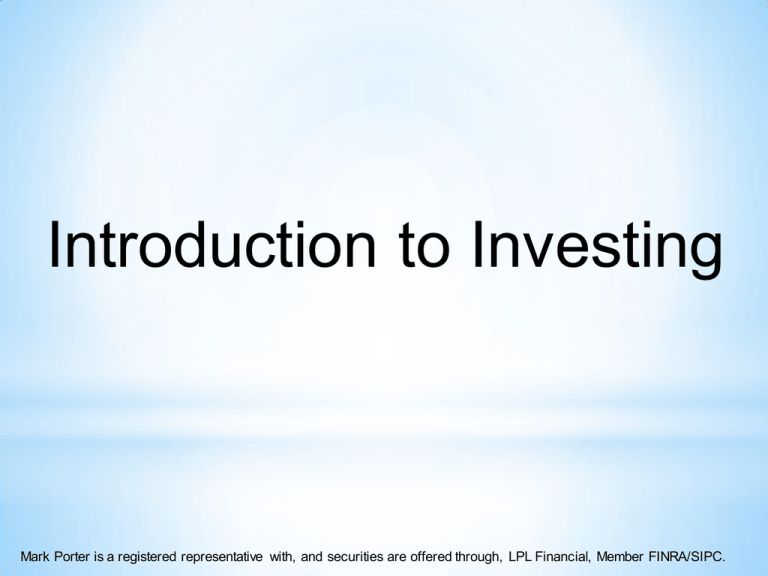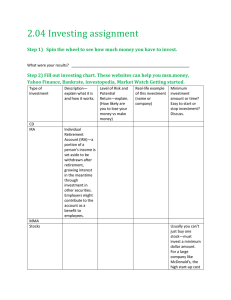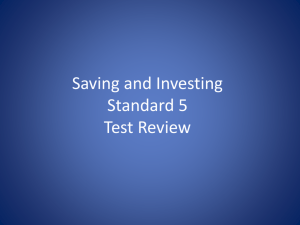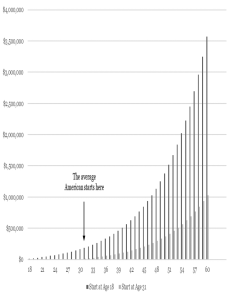Introduction to Investing
advertisement

Introduction to Investing Mark Porter is a registered representative with, and securities are offered through, LPL Financial, Member FINRA/SIPC. Outline My Background Investing Building Blocks A Word about Financial Planning, Debt and Reserves Asset Allocation and Rebalancing The Power of Saving Mutual Fund Share Classes Tax Treatment of Accounts Types of Advisors Other Investing Topics My Background Who I am What I do A Word about Financial Planning, Debt and Reserves What are your goals? Investing decisions start with timeframe. Cash Reserves are the most important and most overlooked aspect of sound financial planning. Cash reserve can be checking, savings, money market type accounts. We recommend a cash reserve of anywhere between 3 and 6 months worth of expenses. Should you invest or pay down your debt? The Power of Saving Age Save Early Save Late 22 $ 2,000.00 $ - 25 $ 9,012.22 $ - 28 $ 17,845.61 $ - 31 $ 28,973.12 $ - 32 $ 31,290.97 $ 2,000.00 35 $ 39,417.62 $ 9,012.22 38 $ 49,654.84 $ 17,845.61 41 $ 62,550.80 $ 28,973.12 44 $ 78,796.00 $ 42,990.59 47 $ 99,260.26 $ 60,648.57 50 $ 125,039.35 $ 82,892.53 53 $ 157,513.56 $ 110,913.51 56 $ 198,421.73 $ 146,211.88 59 $ 249,954.23 $ 190,677.66 62 $ 314,870.34 $ 246,691.74 65 $ 396,645.95 $ 317,253.34 What if you save $2,000 per year for 10 years, starting at age 22 and get a fixed annual 8% rate of return? What if you save $2,000 per year from the age of 32 until age 65? Its not easy to sacrifice lifestyle, but the long term rewards are significant. This is a hypothetical example and is not representative of any specific situation. Your results will vary. The hypothetical rate of return used does not reflect the deduction of fees and charges inherent to investing and is not based on any specific investment. Tax Treatment of Accounts Non Qualified Account Pre – Tax Vehicles* 401(k) / 403(b) / 457 SEP / SIMPLE Post – Tax Vehicles# Roth IRA *These vehicles are funded with pre-tax money, which can provide a current tax deduction. When money is withdrawn later at retirement, taxes are paid on withdrawals at your then current income tax rate. #These vehicles are funded with money that has already been taxed. The Roth IRA offers tax deferral on any earnings in the account. Earnings may be withdrawn tax-free if certain criteria is met. For example, a Roth IRA must be open for at least 5 years, and you must be at least 59½ , which ever occurs later, for earning to be tax free. Limitations and restrictions may a pply. Withdrawals prior to age 59½ may result in a 10% IRS penalty tax. Future tax laws can change at any time and may impact the benefits of Roth IRAs. Their tax treatment may change. Investing Building Blocks Stock Bond Mutual Fund ETF Types of Mutual Funds and ETFs Which is Better? Mark Porter is a registered representative with, and securities are offered through, LPL Financial, Member FINRA/SIPC. Asset Allocation and Rebalancing Efficient Markets Modern Portfolio Theory Manual & Fund Level Other Investing Topics Expense Ratio Brokerage and Wrap Discretion Mutual Fund Share Classes 12(b)1 fees A Share (Upfront) B Share (Back) C Share (Level) I Share (Wrap) No Load Share (DIY) Types of Advisors Accountant Broker Financial Planner Fee Based, Transaction Based, or Both? CFP, CFA, CRPC … Wrap Up My Background Investing Building Blocks A Word about Financial Planning, Debt and Reserves Asset Allocation and Rebalancing Other Investing Topics The Power of Saving Mutual Fund Share Classes Tax Treatment of Accounts Types of Advisors Wrap Up Comment Card Public Speaking Free Consultation



